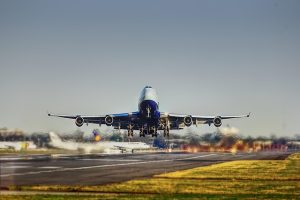
Takeoffs require a substantial amount of thrust. While smaller commercial jets like the Boeing 737 weigh around 90,000 pounds, larger jets like the Airbus A380 weigh over 1 million pounds. To become airborne with all this weight, airplanes must produce a lot of thrust. Most commercial jets, however, use de-rated takeoffs.
What Is a De-Rated Takeoff?
A de-rated takeoff is a procedure that involves taking off from a runway or landing space using a pre-defined, lower thrust setting.
Thrust, of course, is the force that propels airplanes through the air. It’s produced by an airplane’s propulsion system, such as jet engines or propellers. When an airplane’s engines are running, they will produce thrust that propels the airplane forward. A de-rated takeoff is characterized by using a specific, lower-than-maximum thrust setting.
How De-Rated Takeoffs Work
Most de-rated takeoffs are performed using computer software. The software analyzes factors such as runway length, wind, slope, aircraft weight and more. Using this information, it then provides an appropriate thrust setting that’s safe and meets the necessary regulatory requirements.
Pilots can then select the computer-generated thrust setting. Once selected, the airplane won’t be able to generate more thrust than the specified setting. It essentially limits how much thrust the airplane can produce during takeoff.
It’s important to note that de-rated takeoffs aren’t the same as assumed temperature thrust reduction. With assumed temperature thrust reduction, the software simulates warmer conditions to lower the thrust setting but doesn’t actually change the limit. With de-rated takeoffs, the airplane has a ceiling or limit to how much thrust it can produce.
Why Pilots Use De-Rated Takeoffs
You might be wondering why pilots use de-rated takeoffs. After all, a lower thrust setting means it will take longer for airplanes to become airborne and reach cruising altitude. While true, de-rated takeoffs offer several benefits.
One of the main benefits of de-rated takeoffs is engine longevity. It protects aircraft engines from unnecessary wear and tear. Takeoffs place a lot of stress on engines. Over time, this can increase the need for maintenance while shortening the lifespan of engines. De-rated takeoffs protect engines from wear and tear by limiting how much thrust they produce.
De-rated takeoffs can also yield cost-savings benefits for commercial airlines. It reduces fuel consumption during takeoffs while simultaneously protecting engines from wear and tear. The end result is lower fuel and maintenance costs.



